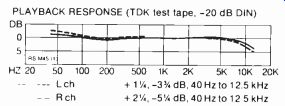A Nifty Nonprofessional Cassette Deck
Technics RS-M45 cassette deck, in metal case.
Dimensions: 17 by 3 3/4 inches, 13 inches deep plus clearance for controls and connections. Price: $350; optional RP-9645 remote control, $31. Warranty: "limited," two years parts and labor; three years on direct-drive motor. Manufacturer: Matsushita Electric, Ltd., Japan; U.S. distributor: Panasonic Co., Division of Matsushita Electric Corp. of America, 1 Panasonic Way, Secaucus, N.J. 07094.



PLAYBACK RESPONSE (TDK test tape: -20 dB DIN)
IN CASE YOU HADN'T noticed, the "component system" approach has replaced the console of yesteryear as the way to get high fidelity if you're intimidated by components themselves. Everything comes prematched, obviating the quandaries that beset even the initiated, and often with ancillary capabilities that are difficult or impossible to find if you're assembling a system on your own. Technics, for example, is among the companies offering full-system wireless remote control if you buy the whole works. So when we dipped into the ensemble by choosing the RS-M45 cassette deck for a look--see test report, we were bypassing a part of its in-system appeal, It does have its own remote control, however: an optional wired model. It also has much of the look. "feel," and technical capability that you'd expect in any Technics deck. Sensibly, considering the intended market, it's shorn of the sort of details that can lend more confusion than performance in the hands of novice recordists: fine-tuning controls for the tape selector's four basic positions, line / mike mixing, multimode metering, and the like. It is a two-head deck whose multiplex filter is switched in along with K the Dolby B noise reduction. But it does have an output level control, a peak-hold feature on the fluorescent signal indicator, a timer-recording mode, recording mute, and direct capstan drive. Thus it is not a barebones deck, by any means.
The tapes supplied by the company along with the test sample included some of its own branded product. When we inquired about tapes that enjoy wider distribution in the U.S. market, Technics suggested testing with TDK SA as the Type 2 ferri-cobalt, TDK MA as the Type 4 metal, and Maxell UDXL-1 as the "normal" Type 1 ferric. The graphs show very good performance with all three.
You'll note that a dissimilarity between the two channels at the very top of the frequency band appears when the noise reduction is switched on for the Type 2 tape. This disparity remained with the other tape types and seems to be occasioned by the multiplex filter, rather than the Dolby B circuit itself. The filtering is extremely sharp in the right channel, with a slight tendency to peak just before the precipitous cutoff; in the left channel, there is no peak, the rolloff is much more gradual, and the filtering action at 19 kHz is less complete. Since we were unable to set up a listening situation in which we could document any audible difference between channels, we consider the point academic.
And replication is good or better with any of the recommended tapes. One reason, certainly, is the very good wow and flutter; since the record/play figures are no higher than those for playback, the test tape may be the limiting factor.
The other DSL measurements are consistent with the values we are used to seeing in non-system components, with one exception: the calibration of the level indicator. In the days of average-reading meters, the headroom implied by a 0-dB calibration 6 dB below DIN's might have been necessary to allow for inherently poor meter response. Since Technics' indicator has excellent response, no headroom is necessary. Its low calibration therefore simply encourages the user to waste 6 dB of the deck's potential dynamic range. The ingenious manual, which is more graphics than text, does explain this point very well, but we wonder which will influence the intended user more, the manual or the change from white to red when the "bar graph" passes its 0-dB marking. Calibration goes down to -20 dB; bar increments are 1 dB apart around the 0-dB mark but 2 dB apart in the most critical range around +6--not a meter for the serious recordist, in our judgment. but adequate to the present need.
And there is a need for a deck like this. The difficulty of selling equipment in economically "soft" times has, unfortunately, led to an overemphasis on technological glitter, and all too many moderate-priced decks are fitted out with switches and knobs about whose correct deployment users are more than a little foggy. The RS-M45 aims at being a quality deck, not a "professional" one--a distinction we wish more companies would keep firmly in mind. From the logic of its transport/mode controls to the rather nifty remote-control option (which even includes a RECORD MUTE button), from the styling to the specs, Technics has succeeded in that aim.
--------
(High Fidelity, Jul. 1981)
Also see: